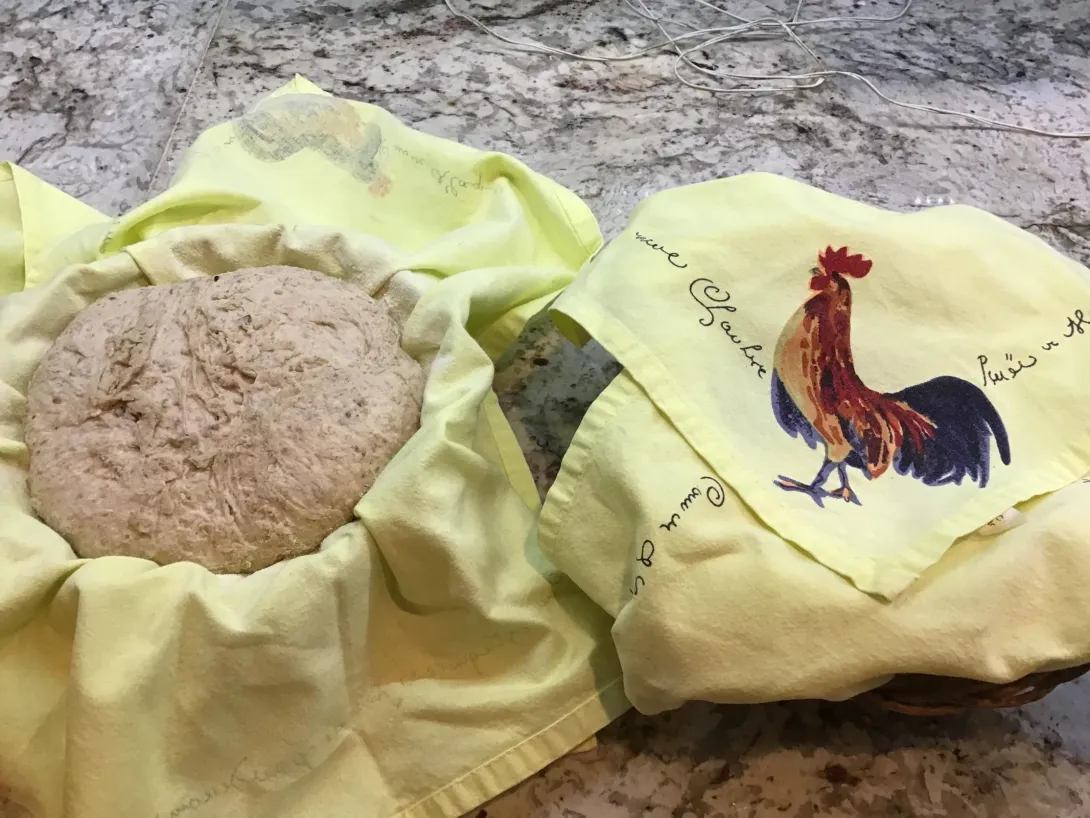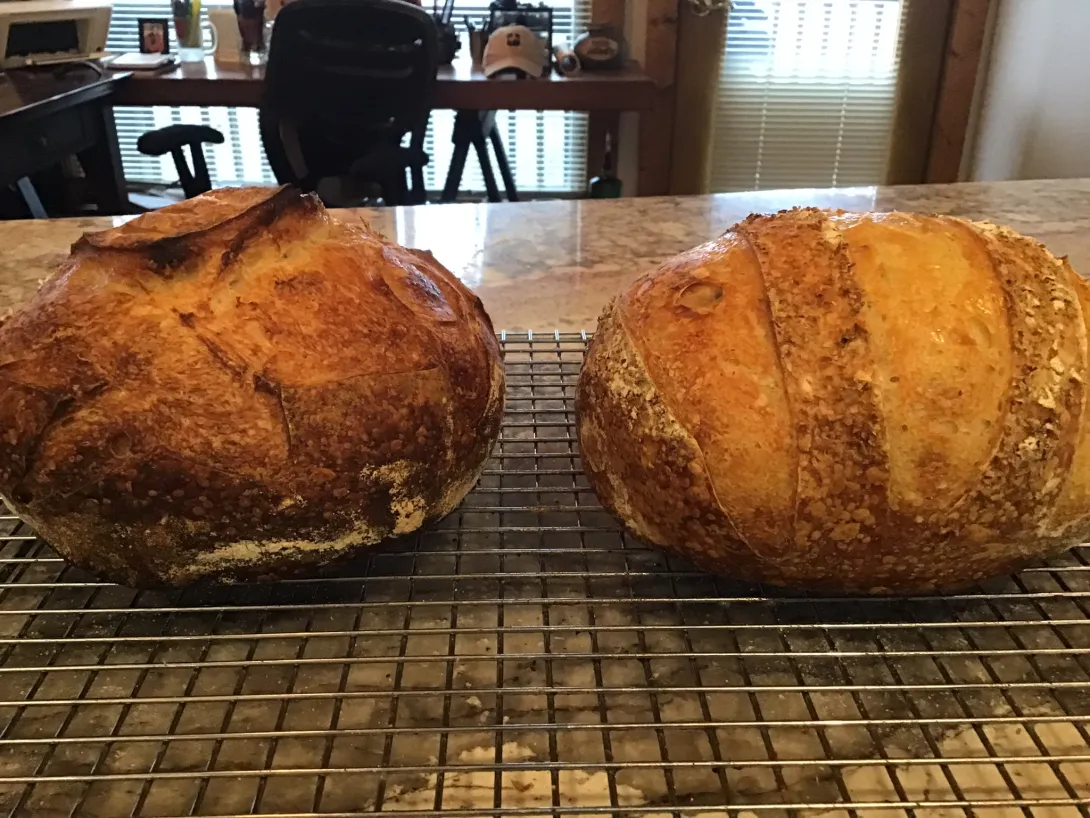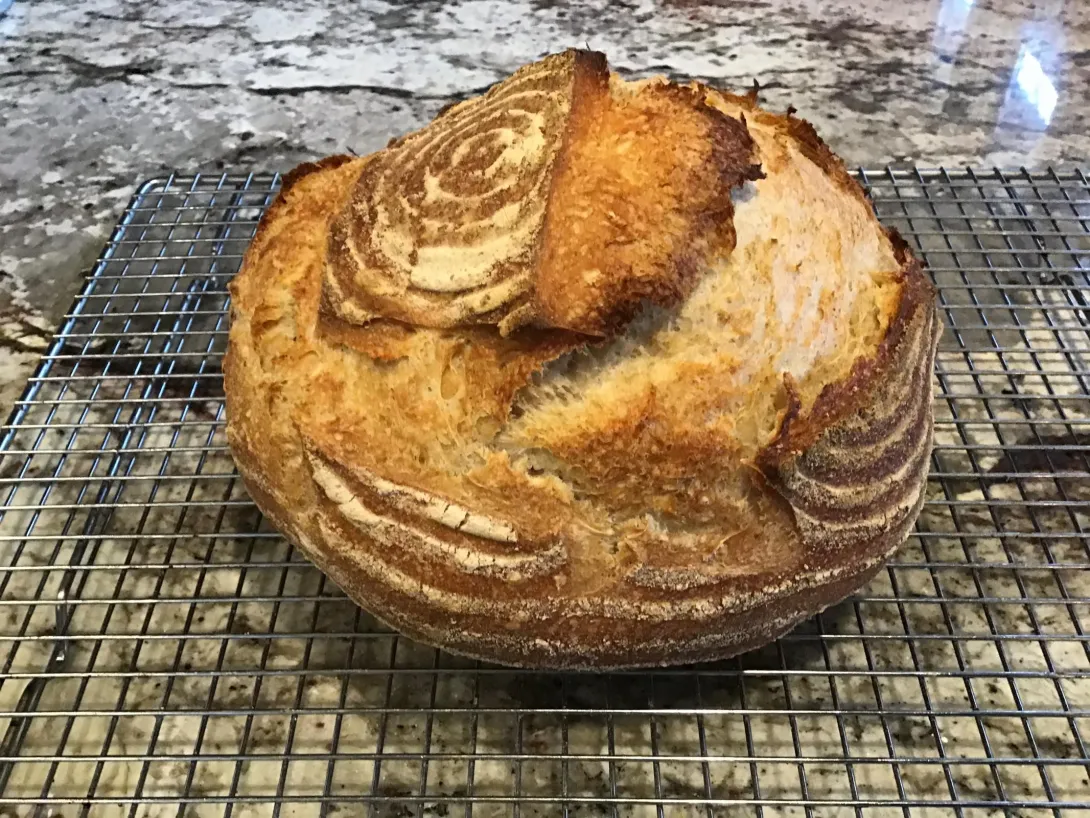I don’t have a bag big enough to hold my bannetons. Is it ok to just put the bannetons straight in the fridge with the loaves covered with terry cloths? I think I’ve done this before and don’t remember any negative effects.
Jack is a prominent sd baker. See Final Proof (step 7) where he recommends refrigerating the shaped dough overnight without a cover. I found that statement interesting, although I’ve not tried it yet.
I always cover the dough for fear of drying out, but bagged dough that is retarded is always covered with water from condensation.
I have baked 2 batches of Bake with Jack’s sourdough, one completely uncovered, the second batch lightly covered with cloth napkins and got great results both times. These baby boules are from my second batch, refrigerated with the cloth napkins folded over the tops.
Adriana, I’m glad you posted. It was your bread that lead me to Jacks post. How would you describe the difference between covered and not covered during retardation?
Dan, this big boule was retarded naked in a terracotta banneton. It had a “crunchier” exterior whereas the baby boules shown above, which were retarded under lightweight cloth napkins had smoother exteriors. All in all there are too many variables for a side by side comparison. (One more difference, the first bake was done in an earthenware cloche, the babies were baked under stainless steel covers)
No big issues scoring either batch, maybe a tad easier on the cloth basket ones. I recently switched from a curved to a straight lame and am happy with it. Never was comfortable with the curved one.
Next time I make baby boules I can do a side by side comparison of cloth covered vs naked easily.
I would like to work on getting those lovely blisters next. I think spritzing is the key. My problem is by the time I get done wrestling the loaves in the oven I forget to spritz. I try to give them a shot when the covers come off,
I have a probe in my fridge that measures temperature and relative humidity and displays the reading on an external display (as well as sending it to my phone via bluetooth). The relative humidity always seems to be in the 80-90% area. I think this is similar to what you might get in a professional proofer, so I suspect you probably don't need any covering on the bannetons.
Having said that, I do cover mine with a piece of cotton jersey fabric, but there is no need for sealed plastic covers and the like.
Dan, I guess the answer is to run your own experiment, one bagged, one not and check the difference. I use plastic bannetons with cotton jersey liners, which are not what most amateur bakers use. I do have some wood pulp brotforms as well.
I get good blisters, but my issue is that my blisters are usually matte, not shiny, whch look nicer - not sure why!
Lance, I don’t get the greatest blisters, but Brad, aka BreadForFun taught me something that really works. In the image below he retarded the freeform loaves on parchment paper that is placed in a pan. The whole thing is bagged and retarded.
I followed his directions and got the same results as he did. I think the breads look super special. The loaves shine as if they were polished.
Here are the kind of blisters I would like to achieve, but I'm not sure what the secret is. I know the pros will be using a deck oven, but I'm not sure that is the issue.
TiSoy, a timely question. I just stumbled upon this. https://www.bakewithjack.co.uk/blog-1/2018/7/5/sourdough-loaf-for-beginners?rq=Sourdough
Jack is a prominent sd baker. See Final Proof (step 7) where he recommends refrigerating the shaped dough overnight without a cover. I found that statement interesting, although I’ve not tried it yet.
I always cover the dough for fear of drying out, but bagged dough that is retarded is always covered with water from condensation.
Dan
I have baked 2 batches of Bake with Jack’s sourdough, one completely uncovered, the second batch lightly covered with cloth napkins and got great results both times. These baby boules are from my second batch, refrigerated with the cloth napkins folded over the tops.
Image

Image

Adriana, I’m glad you posted. It was your bread that lead me to Jacks post. How would you describe the difference between covered and not covered during retardation?
How did it affect the blisters on the crust?
How did it affect the scoring?
Thanks,
Dan
Dan, this big boule was retarded naked in a terracotta banneton. It had a “crunchier” exterior whereas the baby boules shown above, which were retarded under lightweight cloth napkins had smoother exteriors. All in all there are too many variables for a side by side comparison. (One more difference, the first bake was done in an earthenware cloche, the babies were baked under stainless steel covers)
No big issues scoring either batch, maybe a tad easier on the cloth basket ones. I recently switched from a curved to a straight lame and am happy with it. Never was comfortable with the curved one.
Next time I make baby boules I can do a side by side comparison of cloth covered vs naked easily.
I would like to work on getting those lovely blisters next. I think spritzing is the key. My problem is by the time I get done wrestling the loaves in the oven I forget to spritz. I try to give them a shot when the covers come off,
Image

Here is a super article about crust blisters.
https://thebakingnetwork.com/how-to-get-blister-crust-bread/
Have you tried the cornstarch glaze?
I have a probe in my fridge that measures temperature and relative humidity and displays the reading on an external display (as well as sending it to my phone via bluetooth). The relative humidity always seems to be in the 80-90% area. I think this is similar to what you might get in a professional proofer, so I suspect you probably don't need any covering on the bannetons.
Having said that, I do cover mine with a piece of cotton jersey fabric, but there is no need for sealed plastic covers and the like.
Lance
Good info, Lance. Do you think bagging the dough during retardation will enhance the blisters or have no affect in a humid fridge?
Dan, I guess the answer is to run your own experiment, one bagged, one not and check the difference. I use plastic bannetons with cotton jersey liners, which are not what most amateur bakers use. I do have some wood pulp brotforms as well.
I get good blisters, but my issue is that my blisters are usually matte, not shiny, whch look nicer - not sure why!
Lance
Lance, I don’t get the greatest blisters, but Brad, aka BreadForFun taught me something that really works. In the image below he retarded the freeform loaves on parchment paper that is placed in a pan. The whole thing is bagged and retarded.
I followed his directions and got the same results as he did. I think the breads look super special. The loaves shine as if they were polished.
Beautiful loaves, were they flipped over between retardation and baking?
The loaves were retarded and baked in an upright position, as pictured.
Very shiny, Dan!
Here are the kind of blisters I would like to achieve, but I'm not sure what the secret is. I know the pros will be using a deck oven, but I'm not sure that is the issue.
Lance
I am unable to consistently produce blisters like that. I’ve tried Teresa’s method but don't get her results.
Well, I don't think I would like to cornstarch glaze all my loaves anyway - it seems a bit OTT (and messy!).
I think the following factors are at play:
Regarding the steam, I know some bakers steam twice, so I might try this. Something like 15 secs on loaf insertion and 10 secs after 3 mins.
Lance
Means what?
I wonder if cooking the precooking the slurry is necessary? Maybe a side by side trial is in order. The simpler the process the better.
Since I have absolutely zero “cool factor”, I am forced to Google things like that.
Google tells me that “OTT” means Over the TOP.
:D
dan